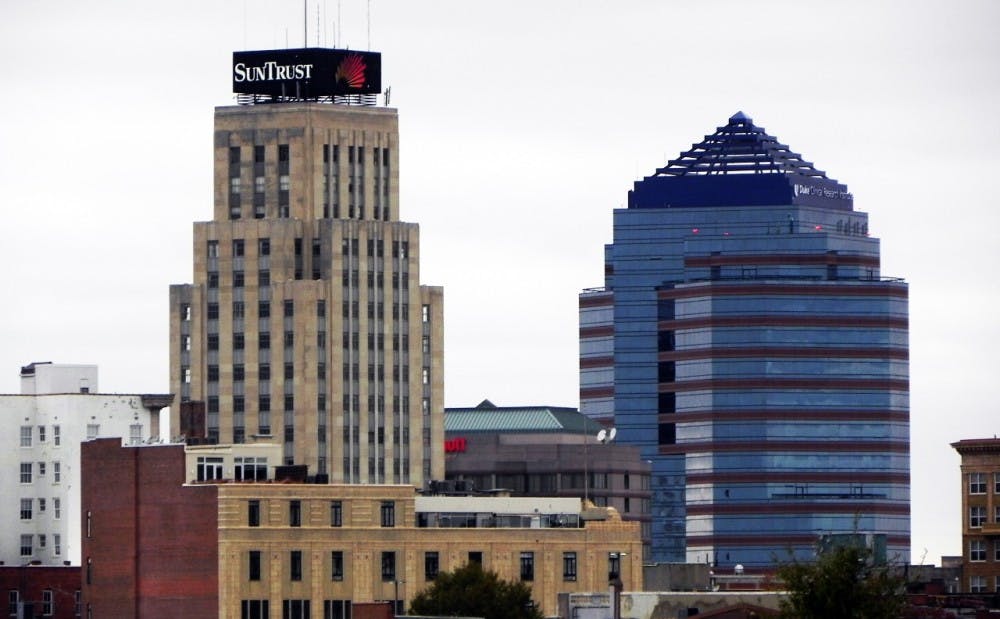Last Wednesday, Durham turned 150 years old.
The city hosted a celebration at the American Tobacco Ampitheater Saturday, which it said would feature free birthday cake, live performances, an inflatable bull race and a keynote speech by Mayor Steve Schewel.
In his speech, Schewel acknowledged that it had been "a tough week" for the city. An explosion in downtown Durham leveled Kaffeinate Coffee shop, killed its owner and left dozens injured on Wednesday—on its exact 150th anniversary of incorporation.
Schewel said that when he came to the scene in the aftermath of the blast, he felt '"a definite sense of tragedy and loss" but was proud of how first responders handled the situation.
"It was a very difficult time and a sad time, but a time to be proud, also," he said.
How Durham came to be
Durham was first incorporated on April 10, 1869 as a small train station. The train depot was built on four acres of land donated by Bartlett Durham, a physician for whom the city was later named after, according to a PowerPoint by Lynn Richardson, retired head of the North Carolina Collection of the Durham County Library, obtained from the Durham County Library. The train enabled the tobacco industry to boom.
When the Confederate army surrendered at the end of the Civil War, the largest troop surrender occurred in Durham County, and the opposing generals met at Bennett's farmhouse 3.5 miles west of town.
During the period of negotiation, soldiers from both sides looted the area, and they discovered a type of tobacco that they had never tasted before, said Elizabeth Shulman, librarian at the North Carolina Collection of the Durham County Library.
“All these farmers came home and discovered that their crop was gone and imagined that they were in financial ruin,” Shulman said.
When the soldiers returned home, however, Durham farmers received floods of letters. They found a nation of new customers, Schulman said.
Washington Duke was one of the farmers who benefitted from the city’s tobacco boom. By the late 19th century, the Duke family controlled the largest share of the tobacco industry in the world, according to the Duke Homestead website.
When Duke retired from the family business in 1880, he began to invest in a small Methodist college in the area. Located just more than an hour outside of Durham, Trinity College was a small Methodist school with barely enough funds to operate. With the financial support of Duke, Durham successfully bid against Raleigh for the relocation of Trinity College, which later became Duke University, according to the Duke Homestead website.
Like the rest of the nation, race relations in Durham were poor. Barred by segregation laws, African Americans built their own self-sustaining communities, said Robert Korstad, professor emeritus of public policy.
The North Carolina Mutual Life Insurance Company—now the oldest and largest African American insurance company in the United States—was founded as a result of African Americans’ inability to find affordable life insurance in Durham, according to the North Carolina History Project website. This company, along with other companies on "Black Wall Street" at the turn of the 20th century, helped propel Durham to have the highest concentration of black millionaires in the country.
But it all came crashing down.
The second half of the 20th Century
Hayti, a piece of land at the angle formed by Pettigrew and Fayetteville streets, formed the nucleus of African American life in Durham. In the 1960s—as an attempt to improve housing and transportation between Durham and its neighboring regions—the city created an urban renewal plan, which promised to replace Hayti with a revitalized neighborhood.
Then-newly-built Highway 147 cut through Hayti and was devastating for black businesses.
The neighborhood was bulldozed and never rebuilt, and more than 4,000 families and 500 businesses permanently displaced, according to the Bull City 150 website.
As Duke University and Research Triangle Park grew, the African American community in Durham continued to suffer, Korstad said.
“With desegregation, the black business community began to lose its place. It didn’t have the capital and resources to compete with white businesses,” said Korstad. “And with the loss of tobacco industry and textile jobs, there was more and more deterioration of downtown.”
'Where we are today'
As new restaurants and high-rises populate downtown, Durham is seeing a revitalization that comes at a cost, Korstad said.
“The effect of increasing property values and gentrifying neighborhoods has largely been on African Americans," Korstad said. "The increasing prosperity and higher earning capacity of people who are moving to Durham are forcing people who live here out."
Korstad—faculty director for the Bull City 150 research project—said that understanding Durham history is invaluable to its continued growth. Bull City 150 is an initiative that celebrates Durham’s birthday by studying the history behind the city’s contemporary inequalities, Korstad said.
“There are straightforward public policies that have created the inequities that exist today,” Korstad said. “Our understanding is that if you’re going to redress these inequities, you can’t do that unless you understand how you got to where we are today.”
Get The Chronicle straight to your inbox
Signup for our weekly newsletter. Cancel at any time.

